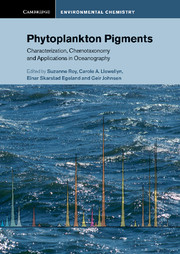Book contents
- Frontmatter
- Contents
- Contributors
- Preface
- Acknowledgements
- Abbreviations and symbols
- Part I Chlorophylls and carotenoids
- Part II Methodology guidance
- Part III Water-soluble ‘pigments’
- Part IV Selected pigment applications in oceanography
- Part V Future perspectives
- Part VI Aids for practical laboratory work
- Appendix A Update on filtration, storage and extraction solvents
- Appendix B HPLC instrument performance metrics and validation
- Appendix C Minimum identification criteria for phytoplankton pigments
- Appendix D Phytoplankton cultures for standard pigments and their suppliers
- Appendix E Commercial suppliers of phytoplankton pigments
- Part VII Data sheets aiding identification of phytoplankton carotenoids and chlorophylls
- Index
- Plate Section
- References
Appendix A - Update on filtration, storage and extraction solvents
Published online by Cambridge University Press: 05 March 2012
- Frontmatter
- Contents
- Contributors
- Preface
- Acknowledgements
- Abbreviations and symbols
- Part I Chlorophylls and carotenoids
- Part II Methodology guidance
- Part III Water-soluble ‘pigments’
- Part IV Selected pigment applications in oceanography
- Part V Future perspectives
- Part VI Aids for practical laboratory work
- Appendix A Update on filtration, storage and extraction solvents
- Appendix B HPLC instrument performance metrics and validation
- Appendix C Minimum identification criteria for phytoplankton pigments
- Appendix D Phytoplankton cultures for standard pigments and their suppliers
- Appendix E Commercial suppliers of phytoplankton pigments
- Part VII Data sheets aiding identification of phytoplankton carotenoids and chlorophylls
- Index
- Plate Section
- References
Summary
Filtration
In Chapter 10 of Jeffrey et al. (1997), Whatman GF/F (or equivalent) filters (0.7 μm nominal pore size) were recommended for sample filtration. With the exception of targeted studies, GF/F filters remain the most commonly used media for routine filtration and accompanying in vitro analyses by HPLC, fluorometry and spectrophotometry. As indicated in the above-mentioned Chapter 10 (p. 284–287), many studies have compared the effectiveness of different filter types and highlighted their advantages/disadvantages. Of particular note are three relatively recent papers highlighting the limitations of GF/F filters. Knefelkamp et al. (2007) compared six different filter types and concluded that Whatman nylon membranes (0.2 μm pore size, 47 mm diameter) provided the most consistent results with respect to chlorophyll a analyses. Nucleopore filters (0.2 μm) have been reported to retain as much as four times the amount of chlorophyll a as GF/F filters in open ocean samples (Dickson and Wheeler, 1993). Furthermore, Lee et al. (1995) reported that GF/F filters retained only 13–51% of small bacterioplankton (< 0.8 μm diameter) in natural samples. In contrast, recent comparisons of filter types have reported no differences in pigment concentrations obtained using GF/F and membrane filters in a variety of aquatic habitats (Chavez et al., 1995; Morán et al., 1999). The choice of filter type, whether glass-fibre or membrane, should be determined by the individual investigator for their particular application. However, once a filter type is selected, it should be used uniformly for sample filtrations to insure consistency between samples.
In estuarine and coastal waters, particulate matter (seston) may result in rapid saturation and ‘clogging’ of filters. Continued vacuum filtration of ‘clogged’ filters may promote mechanical stress and induce cell lysis, potentially resulting in underestimation of the actual pigment concentrations in the sample (Goldman and Dennett, 1985; Taguchi and Laws, 1988; Richardson and Pinckney, 2004). The total time for sample filtration should not exceed 5–10 min to minimize filter saturation (Wasmund et al., 2006). Filters should be removed as soon as the passage of water through the filter is undetectable and the vacuum should never exceed 50 kPa. Although not commonly used, positive pressure filtration (7–14 kPa) reportedly allows the filtration of larger volumes of water with reduced filtration times (Gibb et al., 2001; Bidigare et al., 2002). Regardless of the filtration method used, multiple filters can be pooled to achieve the biomass necessary for HPLC analyses. After filtration, filters should be folded in half, blotted on absorbent paper to remove excess water, and immediately flash frozen and stored in liquid nitrogen or at −80 °C (Wright and Jeffrey, 2006).
- Type
- Chapter
- Information
- Phytoplankton PigmentsCharacterization, Chemotaxonomy and Applications in Oceanography, pp. 627 - 635Publisher: Cambridge University PressPrint publication year: 2011
References
- 5
- Cited by



